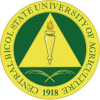Resiliency Center
UNIVERSITY RESILIENCY CENTER
OVERVIEW
The establishment of the Resilience Center at the Central Bicol State University of Agriculture (CBSUA) is inspired by two milestones in the University: the opening of a national pioneering graduate program on Disaster Risk Reduction and Management (Master of Science in DRRM) in June 2008 and the active participation of the University in an FAO pilot project on climate smart agriculture in 2011. These milestones were considered significant strides in a regional landscape where climate-induced disasters bring about havoc and great losses to life and property.
In February 2014, the Bicol Plan of Action (POA) for Disaster Risk Reduction for Agriculture was launched by the Department of Agriculture Regional Field Office 5. The Plan was adopted by the Bicol Regional Development Council and forms part of the regional strategic actions for disaster preparedness and climate change mitigation. The POA is an output of a UN FAO multi agency initiative with CBSUA as a key partner.
The Bicol POA is a document that stems from a major regional development concern: climate related disasters limit the growth of the Bicol Region. This has always been the case of the Bicol Region and most parts of the Philippines. It is a country at the typhoon path and located at the ring of fire. An average of 3-5 major direct-hit-typhoons occur in the region in a period of 2-3 years. Often , these hazards have led to disasters. This caused millions of pesos in losses to agriculture, fisheries and other small scale enterprises. As such, areas in the eastern seaboard of the country are one of the poorer communities in the Philippines.
In 2006, the World Bank reported that Bicol, the CARAGA region, and Regions 7 and 8 are among the most vulnerable places for climate risks. This ushered the implementation of FAO assisted projects aimed to address the impacts of climate related hazards due to inadequate preparedness, mitigation and response to emergency situations that result in damage, loss of lives and livelihoods in the agriculture, aquatic and natural resources (AANR) sectors. The major focus was to enhance livelihoods resilience of small-scale farmers and fisher folks in disaster-prone areas through institutionalization of DRR/CCA in agriculture.
As such, CBSUA as the agricultural university in Bicol has actively partnered with the UN-FAO project focused on developing community based DRRM systems (CBDRRM) as a mechanism to improve and institutionalize knowledge and practice of DRR/CCA for agri-fisheries in the local governance systems. This includes: (1) a community-based hazard risk and vulnerability capacity assessment and planning, (2) an early warning (EWS) and climate information system, (3) small scale DRR/CCA good practice technology options for farmers and fishers in hazard prone areas, and (4) a post disaster needs assessment system (PDNA).
Likewise, in early 2013 USAID and UPLBFI identified CBSUA as a co implementing agency of Bicol Agri-Water Project; A Climate Change Adaptation Strategy for the Agriculture Sector. The project’s products include; (1) local climate provisioning service systems for rice, (2) climate decision support tools for agriculture, and (3) climate farmer’s field schools. These products were developed in participation with local governments and were mainstreamed in the local governance systems.
In 2016, PCARRD DOST in collaboration with CBSUA has launched the pilot implementation of the Science and Technology Action Frontline for Emergencies and Hazards in the AANR sector (SAFE). SAFE aims to provide research-based solutions at managing and reducing risks at the farm level. SAFE was able to develop system protocols at responding to agricultural emergencies brought about hydro-meteorological disasters.
With these initiatives and outputs, climate smart agriculture production systems and livelihood systems were integrated into the local development processes and in the local development investment agenda. In essence, the enabling environment to further enhance capacities with CBSUA as a frontrunner is in place.
The Resilience Center builds on the learning experience and good practices developed by these projects as a means of mainstreaming climate smart systems and DRRM systems in the Bicol Region.
In most ways, it is envisioned to sustain and enhance the enabling climate smart initiatives and measures for resilient and sustainable agri-fishery producing communities in the Bicol Region. The creation of a Resilience Center at CBSUA is a means at institutionalizing the University’s efforts and streamline support to regional development.
The Resilience Center was instituted as the University Focal Unit in DIsaster Risk Reduction and Management (DRRM) and in Climate Change Adaptation and Management (CCAM) during the time of Dr. Maria Dulce J. Mostoles, the Vice President for REPED with the efforts of Prof. Philip N. Talay, Director – RCDRRM&CCA and Dr. Aries O. Ativo, UEM Officer through the BOR Resolution No. 67, Series of 2019. Prof. Talay has been designated as the first Director of the CBSUA Resilience Center through the titulage of the University President, DR. Alberto N. Naperi.
VISION, MISSION, OBJECTIVES
Vision
To provide a top-notch disaster response and become a premier DRRM & CCA learning and research center of the CBSUA community and its stakeholders by providing a comprehensive DRRM & CCA program.
Mission
The CBSUA Resilience Center shall provide the highest level of DRRM & CCA information and quality services to students and other stakeholders in pursuit of the university’s commitment to safety and resiliency and academic excellence.
Objectives
The CBSUA Resilience Center shall provide multidisciplinary action at ensuring environmental integrity and reducing the impacts of climate and disaster risks.
Specifically, the Center shall:
- Conduct research to improve climate and disaster risk management, and environmental management
- Organize a management of a Knowledge and Information Network to hasten knowledge sharing
- Offer capacity development efforts and expert technical services to increase local level capabilities
- Provide expert services to improve local governance and management systems
- Oversee the University Level DRRM response and environmental management systems


